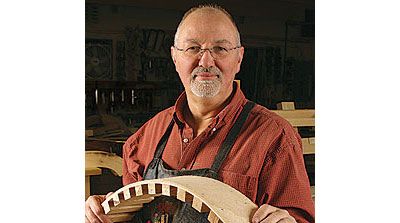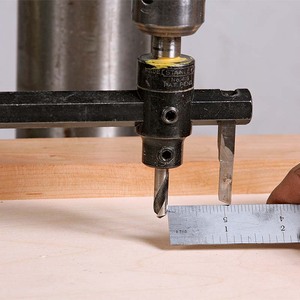
Read our question and answer session with Michael Fortune, a new contributing editor to Fine Woodworking magazine.
Famed furniture-maker Michael Fortune is a new contributing editor to Fine Woodworking magazine. Learn more about him in this question and answer exchange with our editors.
Tell us about your early woodworking life…
My parents gave me tools for every birthday and Christmas beginning when I was five or six years old. My godparents bought every birdhouse and lawn chair I made–that was how I made spending money when I was a kid.
I spent each winter making my own hockey stick, it was invariably finished just as the season was over. The next woodworking project was a baseball bat, which in turn was finished… Then there was lacrosse…
Can you tell us any funny stories from your early woodworking life?
I was given a tablesaw from a chain store when I was ten years old and made a kayak from plans ordered from Popular Mechanics magazine. I couldn’t afford to buy enough wood to make a form to keep the kayak keel straight as it was built so when I finally put it in the water I discovered you only had to paddle on one side to go straight. That wasn’t too bad, until you wanted to turn right, then you had to paddle like hell.
How did you end up as a furniture designer?
I was enrolled in graphic design at Sheridan College in 1970 and was sent to another campus to deliver a cardboard box to an administration office.
Left and right have always been a challenge so I got lost and ended up in the wrong parking lot. I entered the wrong door only to bump into the instructor for the furniture design program.
I asked what I thought was a simple question “what do you do here”? Four hours later, I was completely indoctrinated. I went back to my original campus and changed programs. I have been doing this ever since.
I consider this to be the perfect career choice. I am self-employed with a committed crew of skilled craftspeople in my studio. I commute to work, about 600 ft., past bunnies that no longer scurry into the woods.
I work with really interesting clients all over North America. I only do exactly what I want to do. I also work as a consultant for International Aid groups such as The Commonwealth Secretariat, United States Dept of Agriculture, Institute for Tropical Forestry and Aid to Artisans CT USA. I will go to a site (Central America, Caribbean) and design wood products using local sustainably grown woods combined with available technology and skill levels. It is a wonderful challenge and it is always rewarding to work closely with people who are so hardworking and eager to learn.
Who has influenced your work?
When I was a student there was an elderly technician, Bruno Armillen, in the furniture design studio who helped the students fabricate their design projects. Bruno was so unbelievably at peace with himself. He knew he could make anything, in any circumstance. He had survived World War II as a prisoner of war in a camp in Central Africa because he was valued for his skill.
I was always fascinated by his fingers, he would be talking to you while his fingers performed the most intricate of tasks. Thirty years later, I stand at my workbench and watch my own fingers (they survived using a tablesaw when I was ten) do the same without any effort.
After graduating from design school in 1974 I was very fortunate to have received a Canada Council grant to travel and study in Europe. I sent out hundreds of letters looking for opportunities. One of the few responses was from a British designer/maker Alan Peters. I had never really been exposed to (very rare in North America at that time) someone designing furniture and then making it too.
I worked for Alan in the fall of 1974 and it struck me that here was someone that was in complete control–very unlike the scenario found in a typical design office where the client(s) often pull the strings. My lifestyle, work environment and philosophy are very much in alignment with Alan Peters.
In repayment of the debt for Peters letting a Canadian design student in his workshop, I now have an intern position in my studio. We have had people from Indiana, Oregon, PEI, Saskatchewan etc. The next person is from Illinois, they’ll start in the spring. The point of the exercise is to give promising individuals a chance to observe a functioning design/craft studio.
What are your plans for the future?
I wondered from time to time what I would do when I retire – take up accounting? Accountants seem to take up woodworking.
I finally met one of my heroes, Sam Maloof in San Fransisco, Calif. We were both speaking at a conference in Phoenix, Ariz. He was eighty-six years old and drove himself to the conference from San Francisco in his new Porsche. (He still bought his wood green and air dried it himself, a process that can take 2-5 years.) Question answered…
Tell us about your furniture-making path…
The first ten years after school were slim until I had honed my woodworking skills. The Taunton Press began publishing Fine Woodworking magazine just when I needed technical guidance and I am indebted for their addition to my knowledge base. I wasn’t alone but was part of a community across North America. Over the years I developed confidence in my ability to design. I build what I feel is appropriate and then present it to the client. I am often working with very successful people in their respective fields and they approach me to design something for them. It is up to me to provide an innovative and highly-resolved solution for that specific commission.
I am continually amazed that someone doesn’t burst into my workshop and scream “what the hell do you think you are doing, you’re having way too much fun and you’re making your living at it! This is going to stop right now!”
You spend a significant amount of time each year teaching. Any teaching memories that stand out for you?
I teach short courses, two or three weeks long, at a variety of art centers and woodworking schools all across the United States. They are always filled up and with a waiting list.
I had a person from Illinois take a course in Colorado. He showed me his portfolio, very common work, all Victorian style furniture. He showed up at a course in Indiana five years later with the most unbelievable portfolio that he had done in the interim. He said his more creative approached actually helped his day job as an engineer.
Another memorable experience was working with a group in Quintana Roo, Mexico. It was very remote with the barest of equipment. I went down several times, working very closely with two young carpinteros that in turn continued to work with the larger group. This was an export venture sponsored by the USDA. Five years later I was in NYC and saw their work in a window display. I went in and read the tag – Linea Fortuna. The Fortune Line. Now that’s a wonderful feeling.
Any final thoughts on being a furniture maker?
I never would have become a furniture designer/maker if I thought it would be impossible to pursue my artistic vision and make an acceptable living at the same time. I tried to meet as many successful furniture designers and makers as possible when I was starting out to learn from their experiences, not just their furniture, to determine what approach worked well.
Commitment to their own vision was the common thread.
Click here for all our online articles and videos with Michael Fortune.






















Comments
Congrats to Michael and Fine Woodworking. Michael's articles and videos for FWW have been superb. He is an extremely inventive and enthusiastic person. I had the fortune to take a two course from him. He made it a point to help each of the sixteen students on problem solving and design individually each day.
What brand of vacuum press to buy. I am a hobby man . Thank You
Log in or create an account to post a comment.
Sign up Log in